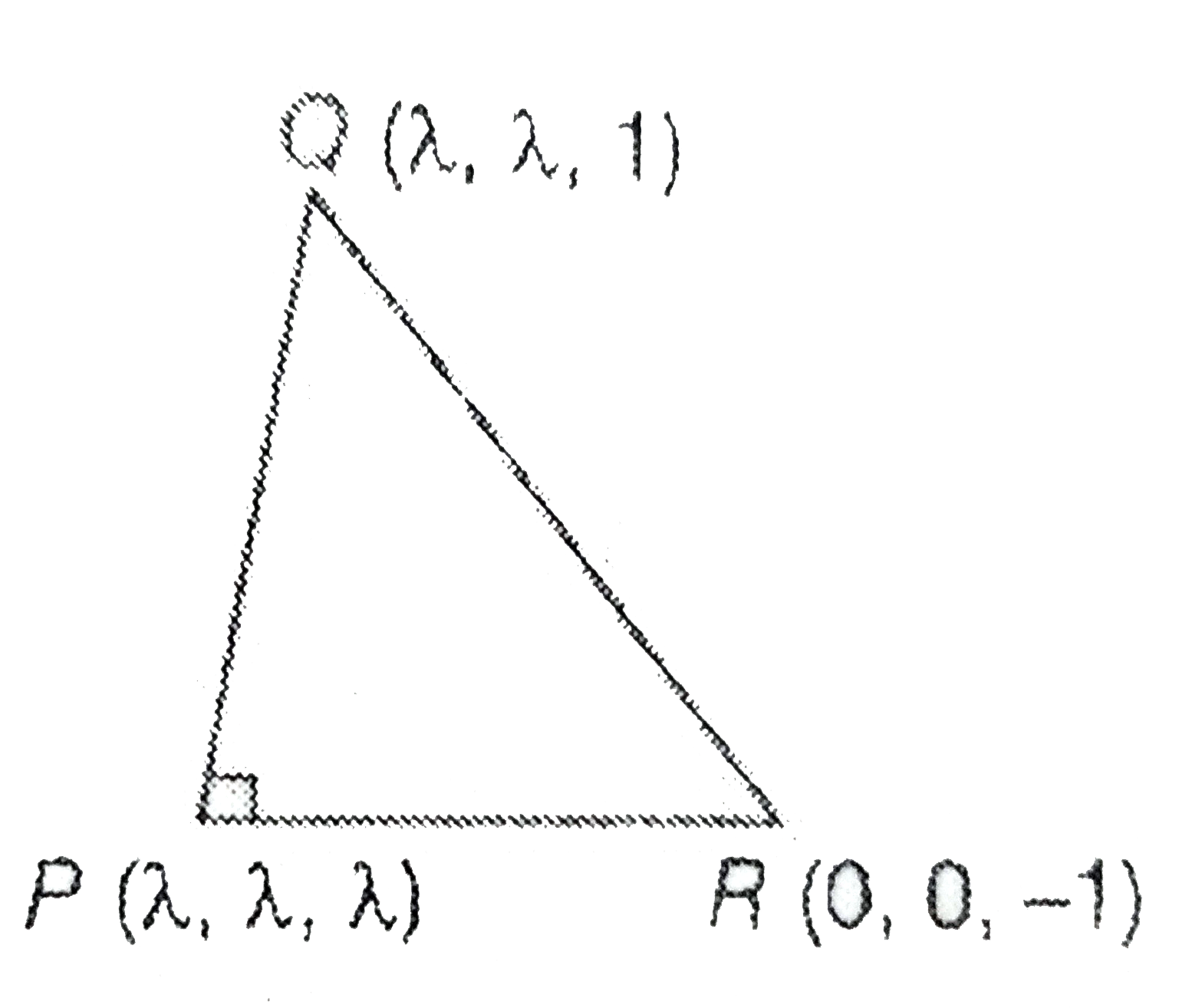From a point P(λ,λ,λ), perpendicular PQ and PR are drawn respectively on the lines y=x,z=1 and y=−x,z=−1.If P is such that ∠QPR is a right angle, then the possible value(s) of λ is/(are)Solution in Tamil
√2
1
-1
−√2
The correct Answer is:C
(i) Direction ratios of a line joining two points (x1,y1,z1) and (x2,y2,z2) are x2−x1,y2−y1,z2−z1.
(ii) If the two lines with direction ratios a1,b1c1,a2,b2,c2 are perpendicular, thena1a2+b1b2+c1c2=0
Line L1 is given by y=x,z=1 can be expressed
L1:x1=y1=z−10=α [say]
⇒ x=α,y=α,z=1
Let the corrdinates of Q on L1 be (α,α,1).
Line L2 given by y=−x,z=−1 can be expressed as
L2:x1=y−1=z+10=β [say]
⇒ x=β,y=−β,z=−1
Let the coordinates of R on L2 be (β,−β,−1).
Direction ratios of PQ are λ−α,λ−α,λ−1.
Now, PQ⊥L1

∴ 1(λ−α)+1.(λ−α)+0.(λ−1)=0⇒λ=α
Hence, Q(λ,λ,1)
Direction retios of PR are λ−β,λ+β,λ+1.
Now, PR⊥L2
∴ 1(λ−β)+(−1)(λ+β)+0(λ+1)=0
λ−β−λ=0
⇒ β=0
Hence, R(0,0,−1)
Now, as ∠QPR=90∘
[as a1a2+b1b2+c1c2=0, if two lines with DR's a1,b1,c1,a2,b2,c2 are perpendicular]
∴ (λ−λ)(λ−0)+(λ−λ)(λ−0)+(λ−1)(λ+1)=0
⇒ (λ−1)(λ+1)=0
⇒ λ=1
or λ=−1
λ=1, rejected as P and Q are different points.
⇒ λ=−1
Similar Questions
The system of linear equations x+λy−z=0;λx−y−z=0,x+y−λz=1has a non - trivial solution for how many values of λ
View SolutionMatch the following for the system of linear equations
λx+y+z=1
x+λy+z=λ
x+y+λz=λ2
(##FIITJEE_MAT_MB_07_C02_E04_001_Q01.png" width="80%">
View SolutionP(λ,λ,λ) বিন্দু থেকে y=x,z=1 এবং y=−x,z=−1 সরলরেখার ওপর অঙ্কিত লম্বগুলি যথাক্রমে PQ এবং PR। যদি P বিন্দুটি এমন হয় যে ∠QPR একটি সমকোণী ত্রিভুজ, তবে λ-এর সম্ভাব্য মানটি/মানগুলি হবে।
View SolutionIf the straight lines
x=1 +s,y=-3−λs,z=1+λs and x=t2,y=t ,z=2-t with parameters s and t respectively are co planar then λ =
View SolutionIf the angle between the lines 2(x+1)=y=z+4 and the plane 2x−y+√λz+4 is π6, then the value of λ is
View Solutionयदि सरल रेखायें x=1+s,y=−3−λs,z=1+λs तथा x=t2,y=1+t,z=2−t जिनके प्राचाल क्रमशः s1 व s2 है, समतलीय हो ' तो बराबर है-
View Solutionबिंदु P(λ,λ,λ) से रेखाओं y=x,z=1 तथा y=−x,z=−1 पर डाले गये लम्ब क्रमशः PQ तथा PR है। यदि ∠QPR समकोण है तो λ का संभावित मान है
View Solutionबिंदु P(λ,λ,λ) से रेखाओं y=x,z=1 तथा y=−x,z=−1 पर डाले गये लम्ब क्रमशः PQ तथा PR है। यदि ∠QPR समकोण है तो λ का संभावित मान है
View Solution
